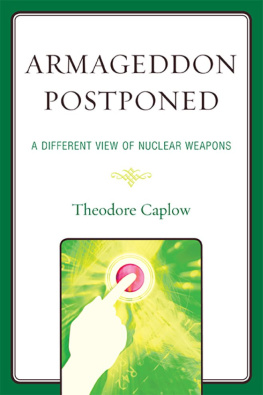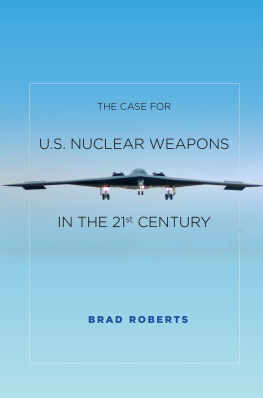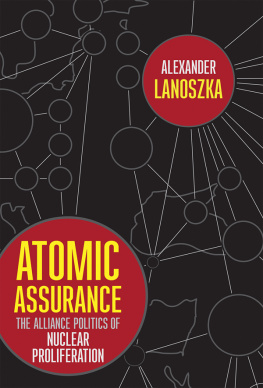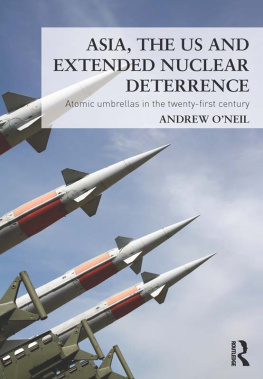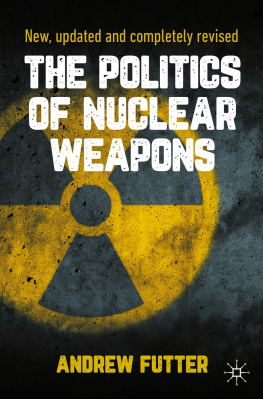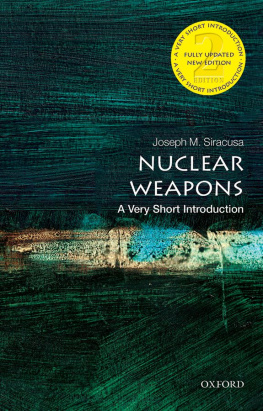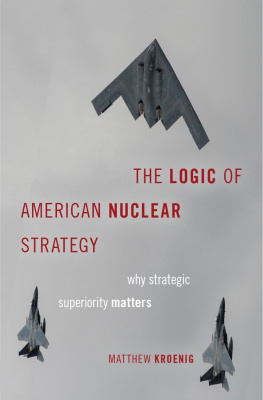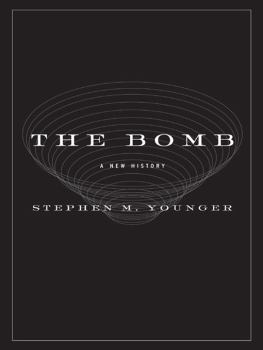Contents
Guide
Pagebreaks of the print version
Too often scholars and policymakers treat nuclear weapons as an intellectual silo, divorced from a states larger strategic behavior and grand strategy. The preeminent historian of nuclear weapons in the world today, Frank Gavin, singlehandedly corrects that mistaken approach in this masterful volume, arguing that, for the United States, its nuclear strategy is part and parcel of its grand strategyits larger geopolitical aims and its approach to providing security for itself and the world. If you want to understand how we got here and where we might be headed, this book belongs not on your shelf, but on your desk.
VIPIN NARANG , associate professor of political science, Massachusetts Institute of Technology
As we approach the seventy-fifth anniversary of Hiroshima and Nagasaki, Gavins essays challenge both policymakers and scholars to reexamine the conventional wisdom about what has kept the nuclear peace. His work is a cautionary and timely reminder that nuclear weapons remain one of the most consequential and dangerous features of the twenty-first century security landscape, which we neglect at our peril.
JAMES B. STEINBERG, professor of social science, international affairs, and law, Maxwell School of Citizenship and Public Affairs, Syracuse University
This important and fascinating collection of essays provides a wide-ranging, critical examination of what we do and still dont know about nuclear deterrence. Drawing on masterly archival work, Gavin illuminates our understanding of nuclear weapons, which havent been fired in anger since 1945, yet play a major, often underappreciated, role in world politics and grand strategy. The book demonstrates that if we want to prepare for the future, we also have to grapple with the past, and it provides essential analysis for doing both.
CAITLIN TALMADGE , associate professor of security studies, Walsh School of Foreign Service, Georgetown University
NUCLEAR WEAPONS
AND
AMERICAN
GRAND STRATEGY
FRANCIS J. GAVIN
BROOKINGS INSTITUTION PRESS
Washington, D.C.
Pictured on the front cover is a nearly four-hundred-year-old white pine bonsai that survived the atomic bombing of Hiroshima. It was gifted to the United States National Arboretum in 1976 for the American bicentennial by Japanese bonsai master Masaru Yamaki as a symbol of friendship between the two countries.
Copyright 2020
THE BROOKINGS INSTITUTION
1775 Massachusetts Avenue, N.W.
Washington, D.C. 20036
www.brookings.edu
All rights reserved. No part of this publication may be reproduced or transmitted in any form or by any means without permission in writing from the Brookings Institution Press.
The Brookings Institution is a private nonprofit organization devoted to research, education, and publication on important issues of domestic and foreign policy. Its principal purpose is to bring the highest quality independent research and analysis to bear on current and emerging policy problems. Interpretations or conclusions in Brookings publications should be understood to be solely those of the authors.
Library of Congress Cataloging-in-Publication data are available.
Library of Congress Control Number: 2019953031
ISBN 978-0-8157-3791-9 (paperback : alk. paper)
ISBN 978-0-8157-3792-6 (ebook)
9 8 7 6 5 4 3 2 1
Typeset in Sabon
Composition by Elliott Beard
To Natalie, grand strategist
CONTENTS
PREFACE
Nuclear weapons haunt U.S. grand strategy like a long-rumored ghost in a large house: invisible, silent, occasionally terrifying, potentially deadly but all but forgotten on a day-to-day basis. Worries that loose fissile materials will fall into the hands of terrorists or that so-called rogue states will develop a weapons program sporadically find their way into the American political and policy consciousness. Most of the time, however, other concerns, with louder constituenciesfrom climate change to trade to regional instability to the return of great-power politicsovershadow the nuclear question in discussions of Americas role in the world. While these are all critically important concerns, nuclear weapons could end life as we know it in an instant. Rarely is there a vigorous public debate and discussion of such a vitally important question: What role do nuclear weapons play in the United States grand strategy?
This disparity is puzzling for several reasons.
First, the United States has spent enormous sums of money on nuclear weapons and the sprawling infrastructure that supports them and is poised to spend much more in the coming decades. Competition for government funds, both for national security and domestic priorities, is fierce. Given these costs, to say nothing of the unthinkable consequences of nuclear use, one would expect a more robust debate over what nuclear capabilities the United States purchases, for what purposes, and in service to what strategies. Second, the United States has gone to great lengths and is likely to continue to inhibit the acquisition of independent nuclear weapons by other states, a goal that shapes its nuclear posture. Third, these strategies of inhibition have been a key driver of many of the far-flung U.S. alliances and security commitments that began during the Cold War and have expanded and deepened in recent decades. At a time when many critics believe our grand strategy is overextended, or that we need to do more to counter the rising power of China and Russia, the relationship between Americas alliances, inhibition, strategy, and nuclear posture demands greater understanding. Fourth, many of these inhibition-based alliances and security arrangements either explicitly or implicitly rely on the promise by the United States to do something horrific and hardly believable: threaten to and if necessary use nuclear weapons to defend its allies. What would American decisionmakers do if called on to satisfy this extraordinary pledge? This terrible prospect has haunted American grand strategy for decades, of course, but for a variety of reasons, the credibility of U.S. nuclear commitments is rarely discussed with the seriousness it merits. Fifth, to the extent that the role of nuclear weapons in American grand strategy is debated, the arguments often pull in two opposing directions: analysts either highlight what they see as the centrality of nuclear deterrence to achieving Americas goals in the world or promote the need to rid the world of the scourge of the bomb. The United States, both in its rhetoric and its grand strategy, has at times managed to hold both of these seemingly mutually incompatible positions.
These issues are of fundamental importance for both the future of the international order and Americas role in it. This book is an effort to place the nuclear question back where it belongs: at the center of debates over past, contemporary, and future U.S. grand strategy. It is also a meditation on the deep challenges faced in trying to ask and answer questions about nuclear weapons.
My previous book, Nuclear Statecraft , examines and recasts the history of Americas strategies with nuclear weapons. Building on research in declassified government materials, it challenges much of our received wisdom about the nuclear past. The present analysis provides a better and more accurate understanding of the origins and evolution of U.S. nuclear strategy and thinking about the bomb. The process of researching, writing, and publishing the book, however, generated new questions and puzzles, which I set to answer in this study.



